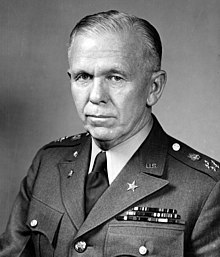
Back George C. Marshall Afrikaans جورج مارشال Arabic جورج مارشال (لعيب فوتبول امريكانى من امريكا) ARZ George Marshall AST Corc Marşall Azerbaijani جرج مارشال AZB Джордж Маршал Byelorussian Джордж Маршал BE-X-OLD Джордж Маршал Bulgarian জর্জ মার্শাল Bengali/Bangla
George Catlett Marshall Jr. GCB (31 December 1880 – 16 October 1959) was an American army officer and statesman. He rose through the United States Army to become Chief of Staff of the U.S. Army under Presidents Franklin D. Roosevelt and Harry S. Truman, then served as Secretary of State and Secretary of Defense under Truman.[3] Winston Churchill lauded Marshall as the "organizer of victory" for his leadership of the Allied victory in World War II. During the subsequent year, he attempted to but failed to avoid the impending Chinese Civil War. As Secretary of State, Marshall advocated for a U.S. economic and political commitment to post-war European recovery, including the Marshall Plan that bore his name. In recognition of this work, he was awarded the Nobel Peace Prize in 1953, the only Army general ever to receive the honor.[4]
Born in Pennsylvania, Marshall graduated from the Virginia Military Institute (VMI) in 1901. He received his commission as a second lieutenant of Infantry in February 1902 and immediately went to the Philippines. He served in the United States and overseas in positions of increasing rank, including platoon leader and company commander in the Philippines during the Philippine–American War. He was the top-ranked of the five Honor Graduates of his Infantry-Cavalry School Course in 1907 and graduated first in his 1908 Army Staff College class.[5] In 1916 Marshall was assigned as aide-de-camp to J. Franklin Bell, the commander of the Western Department. After the nation entered World War I in 1917, Marshall served with Bell who commanded the Department of the East. He was assigned to the staff of the 1st Division; he assisted with the organization's mobilization and training in the United States, as well as planning of its combat operations in France.[5] Subsequently, assigned to the staff of the American Expeditionary Forces headquarters, he was a key planner of American operations, including the Meuse-Argonne Offensive.
After the war, Marshall became an aide-de-camp to then Army Chief of Staff John J. Pershing. Marshall later served on the Army staff, was the executive officer of the 15th Infantry Regiment in China and was an instructor at the Army War College. In 1927, he became assistant commandant of the Army's Infantry School, where he modernized command and staff processes, which proved to be of major benefit during World War II.[6] In 1932 and 1933 he commanded the 8th Infantry Regiment and Fort Screven, Georgia. Marshall commanded 5th Brigade, 3rd Infantry Division and Vancouver Barracks from 1936 to 1938; he received promotion to brigadier general. During this command, Marshall was also responsible for 35 Civilian Conservation Corps (CCC) camps in Oregon and Southern Washington. In July 1938, Marshall was assigned to the War Plans Division on the War Department staff; he later became the Army's Deputy Chief of Staff. When Chief of Staff Malin Craig retired in 1939, Marshall assumed the role of Chief of Staff in an acting capacity before his appointment to the position, which he held until the war's end in 1945.[7]
As Chief of Staff, Marshall, working closely with Secretary of War Henry L. Stimson, organized the largest military expansion in U.S. history, and received promotion to five-star rank as General of the Army. Marshall coordinated Allied operations in Europe and the Pacific until the end of the war. In addition to accolades from Winston Churchill and other Allied leaders, Time magazine named Marshall its Man of the Year for 1943 and 1947.[8] Marshall retired from active service in 1945, but remained on active duty, as required for holders of five-star rank.[9] From 15 December 1945 to January 1947, Marshall served as a special envoy to China in an unsuccessful effort to negotiate a coalition government between the Nationalists of Chiang Kai-shek and the Communists of Mao Zedong.
As Secretary of State from 1947 to 1949, Marshall advocated rebuilding Europe, a program that became known as the Marshall Plan, and which led to his being awarded the 1953 Nobel Peace Prize.[10] After resigning as Secretary of State, Marshall served as chairman of the American Battle Monuments Commission[11] and president of the American National Red Cross. As Secretary of Defense at the start of the Korean War, Marshall worked to restore the military's confidence and morale at the end of its post-World War II demobilization and then its initial buildup for combat in Korea and operations during the Cold War. After resigning as Defense Secretary, Marshall retired to his home in Virginia. He died in 1959 and was buried with honors at Arlington National Cemetery.[12]
- ^ Bland, Stevens & Wunderlin Jr. 1981.
- ^ Tucker 2011, p. 1685.
- ^ Historical Office.
- ^ CNN: George C. Marshall.
- ^ a b George Catlett Marshall Timeline.
- ^ Smith, Truman (1984). Hessen, Robert (ed.). Berlin Alert: The Memoirs and Reports of Truman Smith. Stanford, CA: Hoover Institution Press. pp. 21–22. ISBN 978-0-8179-7891-4 – via Google Books.
- ^ Underwood, Jeffery S. (1991). The Wings of Democracy: The Influence of Air Power on the Roosevelt Administration, 1933-1941. College Station, TX: Texas A&M University Press. pp. 191–192. ISBN 978-0-8909-6388-3 – via Google Books.
- ^ Person of Year Photo 2006.
- ^ Wedemeyer.
- ^ Del Testa, Lemoine & Strickland 2001, p. 120.
- ^ Marshall Is Named Head 1949, p. 6.
- ^ Cathy (11 October 2022). ""Nation Mourns Top Soldier" - The George C. Marshall Foundation". www.marshallfoundation.org. Retrieved 2 August 2023.
Cite error: There are <ref group=upper-alpha> tags or {{efn-ua}} templates on this page, but the references will not show without a {{reflist|group=upper-alpha}} template or {{notelist-ua}} template (see the help page).
© MMXXIII Rich X Search. We shall prevail. All rights reserved. Rich X Search

